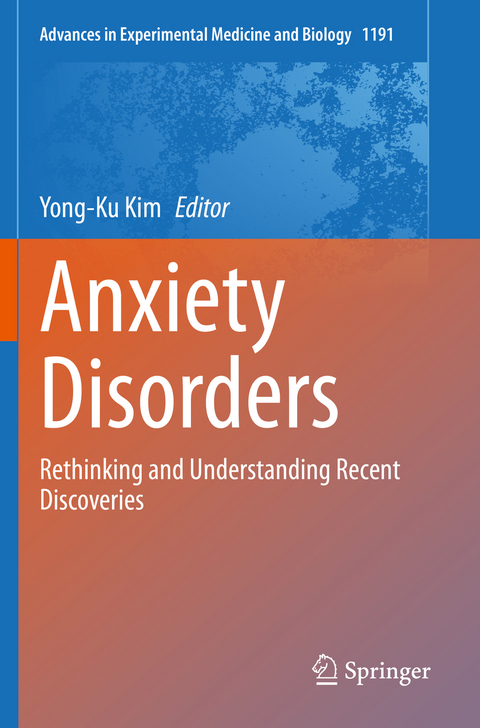
Anxiety Disorders
Springer Verlag, Singapore
978-981-329-707-4 (ISBN)
Anxiety Disorders will be of interest for all researchers and clinicians in the field.
Professor Yong-Ku Kim, M.D, Ph.D., Department of Psychiatry, College of Medicine, Korea University, South Korea Yong-Ku Kim, MD, PhD is a Professor of Psychiatry at College of Medicine, Korea University. He received a MD degree from College of Medicine, Korea University in 1987 and a PHD in psychiatry from Korea University in 1998. Dr. Kim has been affiliated with Korea University since 1998, first as an assistant professor (1998-2000), then as associated professor (2001-2005), professor (2006- present). For the past 20 years, his professional activities have extended beyond the area of pure clinical or research work. Dr. Kim has well over 200 publications in peer-reviewed international journals, including Biological Psychiatry, Molecular Psychiatry, Clinical Journal of Psychiatry, and Progress in Neuropsychopharmacology and Biological Psychiatry and 30 publications of book chapters and have made over 90 academic presentations in my area of interest.Dr. Kim is a fellow of Collogicum Internationale Neuropsychopharmacologicum, International Society for Affective Disorders, World Federation of the Society of biological Psychiatry. He currently sits on the editorial boards of some leading academic journals in the field of neurobiology, including Progress in Neuropsychopharmacology and Biological Psychiatry, Psychiatry Investigation, Brazilian Journal of Psychiatry, Frontiers of Neuroscience, Frontiers of Psychiatry and Neurology and so on. Dr. Kim is also Editor-in Chief of Current Psychiatry Research and Reviews. Dr. Kim received prestigious awards such as Astrageneca Award and Dr. Paul Janssen Schizophrenia Research Award. Dr. Kim is currently the president of Korean society of Biological Psychiatry (2016-present).
Part 1. Brain network concepts.- Chapter 1. Task MRI-based functional brain network of anxiety.- Chapter 2. Phenotype network and brain structural covariance network of anxiety.- Chapter 3. linear/nonlinear micro-and-macro state EEG-based functional networks for anxiety.- Chapter 4. White matter-based structural brain network of anxiety.- Chapter 5. Resting state abnormalities in anxiety disorders and spatiotemporal psychopathology.- Part 2. Neurobiological Aspects.- Chapter 6. Gene-environmental interactions and role of epigenetics in anxiety disorders.- Chapter 7. The role of the oxytocin system in anxiety disorders.- Chapter 8. Translational studies in the complex roles of neurotransmitter systems in anxiety and anxiety disorders.- Chapter 9. The role of early life stress in HPA axis dysfunction in anxiety disorders.- Chapter 10. Immune-kynurenine pathways and the gut-microbiota-brain axis in anxiety disorders.- Chapter 11. Experimental anxiety model for anxiety disorders: relevance to drug discovery.- Part 3. Diagnostic and clinical Issues.- Chapter 12. Anxiety disorders in DSM-5: changes, controversies, and future directions.- Chapter 13. Biological markers to differentiate the type of anxiety disorders.- Chapter 14. Comorbid anxiety and depression: clinical and conceptual consideration, transdiagnostic treatment.- Chapter 15. Anxiety disorders and medical comorbidity: treatment implications.- Part 4. Therapeutic Issues.- Chapter 16. Biofeedback and Neurofeedback for Anxiety Disorders: A Quantitative and Qualitative Systematic Review.- Chapter 17. Cognitive Behavioral Therapy, Mindfulness-Based Cognitive Therapy and Acceptance Commitment Therapy for Anxiety Disorders: Integrating Traditional with Digital Treatment Approaches.- Chapter 18. Neurostimulation in anxiety disorders, post-traumatic stress disorder and obsessive-compulsive disorder.- Chapter 19. Current and novel psychopharmacological drugs for anxiety disorders.- Chapter 20. Role of benzodiazepines in anxiety disorders.- Chapter 21. Virtual Reality for Anxiety Disorders: Rethinking a Field in Expansion.- Chapter 22. Current research on complementary and alternative medicine (CAM) in the treatments of anxiety disorders: evidence based review.- Chapter 23. Contemporary Psychodynamic Approaches to Treating Anxiety: Theory, Research, and Practice.- Chapter 24. Well-being therapy in anxiety disorders.- Part 5. Anxiety and precision psychiatry.- Chapter 25. Personalized clinical approaches to anxiety disorders.- Chapter 26. The role of hormonal and reproductive status in the treatment of anxiety disorders in women.- Chapter 27. Risk factors and prevention strategies for anxiety disorders in childhood and adolescence.- Chapter 28. Anxiety disorders in the elderly.
| Erscheinungsdatum | 24.02.2021 |
|---|---|
| Reihe/Serie | Advances in Experimental Medicine and Biology ; 1191 |
| Zusatzinfo | 25 Illustrations, color; 7 Illustrations, black and white; VII, 576 p. 32 illus., 25 illus. in color. |
| Verlagsort | Singapore |
| Sprache | englisch |
| Maße | 155 x 235 mm |
| Themenwelt | Geisteswissenschaften ► Psychologie ► Biopsychologie / Neurowissenschaften |
| Medizin / Pharmazie ► Studium | |
| Naturwissenschaften ► Biologie ► Humanbiologie | |
| Naturwissenschaften ► Biologie ► Zoologie | |
| Schlagworte | Anxiety Disorders • biological markers • Bio-psychosocial-behavioral Models • brain networks • Diagnosis • DSM-5 Classification • gene-environmental interactions • Neurobiology • neurotransmitter systems • Oxytocin System |
| ISBN-10 | 981-329-707-7 / 9813297077 |
| ISBN-13 | 978-981-329-707-4 / 9789813297074 |
| Zustand | Neuware |
| Haben Sie eine Frage zum Produkt? |
aus dem Bereich


